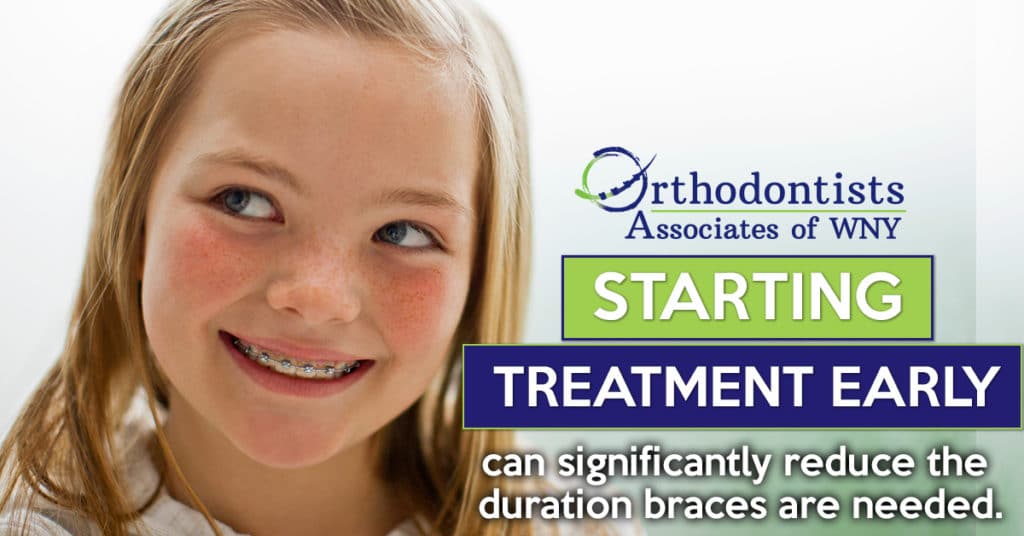There are a variety of reasons your child may require braces including but not limited to crooked teeth, overlapping teeth, gaps, overcrowding, “bad bites” also known as malocclusions or more. Some kids can’t wait to get braces, while for others it may be a daunting time. Your child may be apprehensive about whether it will hurt or worried that they may have to give up some of the activities they love. The good news is that any activity your child loves can be continued once your child gets braces. However your child feels, braces for kids can help keep your child’s mouth healthy for a lifetime.
In the past, the trend for orthodontic treatment was to wait until most or all of a child’s permanent teeth had come in. However, most orthodontic problems are much easier to correct sooner rather than later. This is why professionals recommend and insist upon braces for kids with a focus on early orthodontic treatment. Keep reading to learn about the benefits of braces for kids.
How Do You Apply Braces for Kids?
When a young child comes to our office for their braces, the procedure itself takes around 45 minutes from start to finish. At this point, you will already have had an initial consultation with x-rays of your mouth so we know where the teeth are positioned and whether any permanent teeth are still waiting to come in. Prior to applying the braces, your teeth will be polished and primed with a solution for the adhesive. What is applied next is the bonding glue and then the brackets are placed. Next, the arch wire is slid through and held in place with elastics. Ties are not used unless you are wearing self-ligating braces.
Do Braces for Kids Hurt?
Oftentimes, younger patients may be a little fearful about braces and fear it will be painful. The fact of the matter is that braces for kids are not painful.
The forces braces apply to the teeth, however, may cause discomfort but there is usually no pain associated with the placement of braces. When wires are placed onto those braces and begin to move the teeth, those wires can ultimately cause discomfort; however, that doesn’t usually happen immediately. It usually occurs the following day – and dissipates soon thereafter.
Download Our Free Orthodontic Care Guide
In the past, patients who had braces placed would suffer discomfort for weeks on end but these days, a patient who initiates orthodontics usually experiences some discomfort on the second and third days after the braces are put on and, beyond that point, their teeth will not be sore at all. With the advances in orthodontic technology, many of the materials used have much more flexibility, thereby making it less painful and rigid.
It is always important to monitor any pain during your treatment because if pain persists beyond the first few days, it may be caused by something we as orthodontists need to address. These potential issues include ineffective rubber band wear or wires that may not be doing exactly what they were designed to do. Persistent pain in orthodontics is not a good sign, and if you are experiencing pain, you should definitely contact your orthodontist to get to the root of the issue. (no pun intended!)
Do Braces Interfere with Playing Sports?
Many concerned patients ask, “If I go into orthodontics, will I still be able to play my sports?” At Orthodontists Associates of Western New York, we have had patients play every contact sport imaginable, with any appliance that we construct in this office, so the answer is an unequivocal yes!
Also, the mouthpieces required by some sports can be adapted to fit around any orthodontic appliance we construct, so we feel confident that sports will not interfere with the timing of orthodontics, nor do they adversely affect the decision as to whether or not a patient should undergo orthodontic treatment. In our minds, orthodontics is not a barrier to sports, nor is participation in sports a barrier to orthodontics.
Are There Alternatives to Metal Braces?
While metal braces are still one of the most popular options there are other options. These options include plastic and even ceramic braces that straighten teeth the same way metal braces do. A common alternative that is also one of the best alternatives to metal braces is Invisalign. Invisalign is made from custom plastic trays and will gradually straighten teeth over time. One of the reasons Invisalign is so popular is because it has the capability to be removed for cleaning along with eating. As you could have probably guess, it is also very discreet and almost “invisible” to the naked eye.
Are Braces Available for Adults?
Most people think of teenagers when they think of braces. Many people do get braces during their teenage years but there are more adults receiving braces as the years go on. Invisalign was initially made for adults so they had a discreet alternative to braces. However, there are many adults who desire traditional metal braces or clear braces. If you are an adult interested in perfecting your smile, we have a variety of options available to fit your needs, and your budget. Schedule a free consultation today and let us help you get the answers you need to make an informed decision.
Other Than Improving My Smile, What Can Braces Do?
A lot of people look at braces only as a cosmetic treatment. Of course, there are benefits to having a more confident, straighter smile, there are also many health-related reasons to get braces. Some patients may need their entire bite straightened rather than their individual teeth. Having this corrected can keep your mouth cleaner and healthier. Along with that you can resolve issues such as painful chewing or long-term jaw pain. You will also notice a decrease in cavities, gingivitis and you will overall be more pleased with how your teeth look.
How Long Do Braces for Kids Have To Be Worn?
The average time braces for kids are worn is 1 to 3 years, but that just depends on the child (or adult for that matter). It is different for everyone so there is no right answer. A major factor is cooperation from the patient. This includes wearing auxiliaries such as rubber bands as directed, having good oral hygiene, keeping all of the follow up appointments and avoiding any damaging foods.
What Happens When Braces Are Removed?
When braces are removed, a special tool is used to gently remove and loosen the brackets and wires. The glue and polish are then scraped off so they are nice and smooth and ready to be shown to the world. Getting your braces removed is a painless procedure, and polishing your teeth is no different than a regular cleaning you would receive at your dentists office.
If you have any questions about braces for kids, feel free to contact us to arrange a free consultation for your child, and don’t forget to like us on Facebook!

